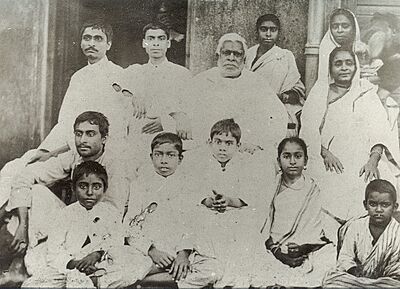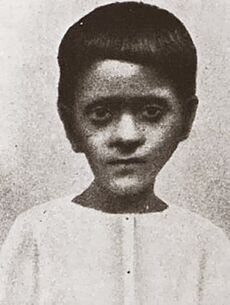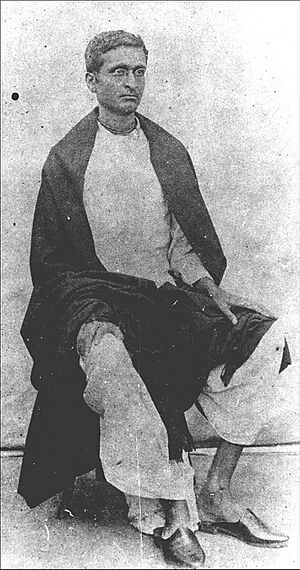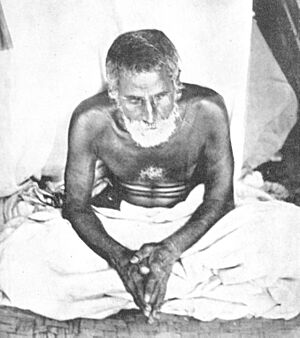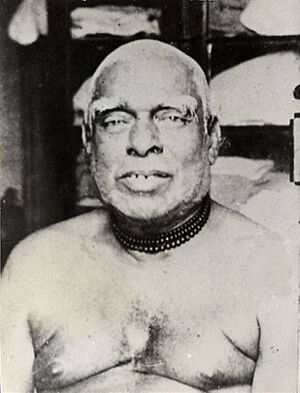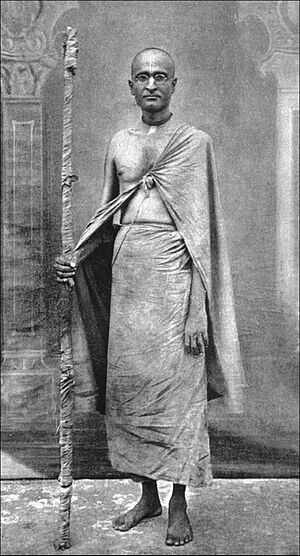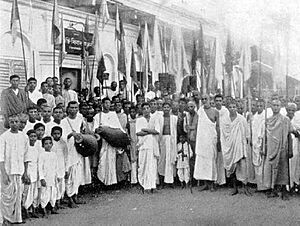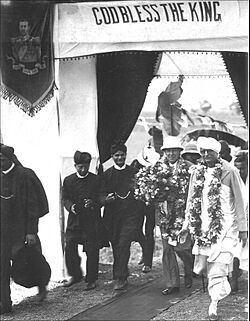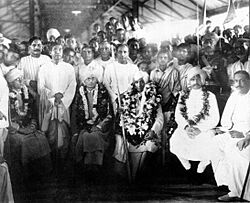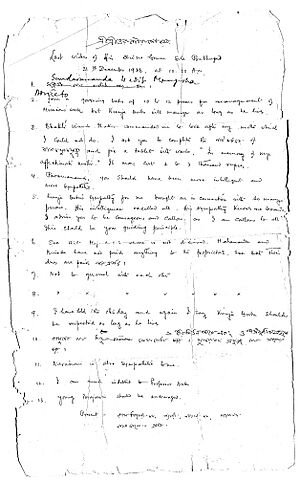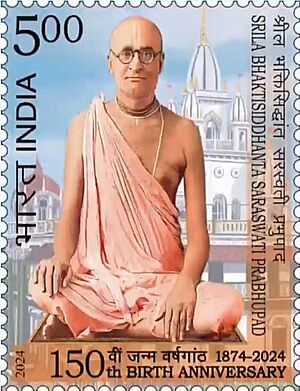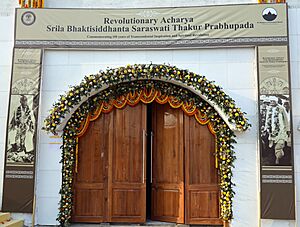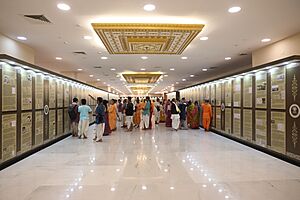Bhaktisiddhanta Sarasvati facts for kids
Quick facts for kids Bhaktisiddhanta Sarasvati |
|
|---|---|
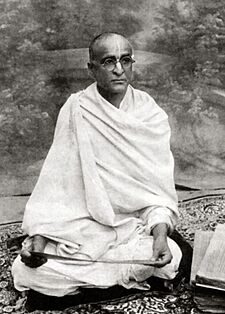 |
|
| Birth Date | 6 February 1874 Puri, Bengal Presidency, British India |
| Died on | 1 January 1937 (aged 62) Calcutta, Bengal Presidency, British India |
| Birth name | Bimala Prasad Datta |
| Guru/teacher | Gaurakisora Dasa Babaji |
| Philosophy | Achintya Bheda Abheda |
| Titles/honors | Siddhanta Sarasvati Prabhupada ("the pinnacle of wisdom"); propagator of Gaudiya Vaishnavism; founder of the Gaudiya Math; acharya-keshari (lion-guru) |
Bhaktisiddhanta Sarasvati (IAST: Bhakti-siddhānta Sarasvatī; Bengali: ভক্তিসিদ্ধান্ত সরস্বতী; Bengali: [bʱɔktisiddʱanto ʃɔrɔʃbɔti]; 6 February 1874 – 1 January 1937) was an important spiritual leader in India. He was born as Bimala Prasad Datt (Bimalā Prasāda Datta). He was a Hindu guru (spiritual teacher) and a philosophy instructor. He helped revive the Gaudiya Vaishnavism tradition in the early 1900s. His followers called him Srila Prabhupāda.
Bimala Prasad was born in 1874 in Puri, India. His father, Kedarnath Datta Bhaktivinoda Thakur, was a well-known Gaudiya Vaishnava philosopher. Bimala Prasad received both Western and traditional Indian education. He became a respected intellectual and was given the title Siddhānta Sarasvatī, meaning "the pinnacle of wisdom." In 1900, he became a follower of Gaudiya Vaishnavism under the spiritual teacher Gaurkishor Dās Bābājī.
In 1918, Bhaktisiddhanta Sarasvati became a sannyasi (a Hindu monk). He then started his own spiritual center in Calcutta, which became known as the Gaudiya Math. This organization grew quickly, opening many branches across India and even in other countries like Burma, Germany, and England. The Gaudiya Math shared the teachings of Gaudiya Vaishnavism through books, magazines, and public events. Bhaktisiddhanta was known for his strong and clear way of speaking and writing. He was called "acharya-keshari" or "lion guru." He worked to bring back the traditional worship of Krishna (called krishna-bhakti). He also spoke out against unfair caste systems and other practices he felt were not true to the original teachings.
After Bhaktisiddhanta Sarasvati passed away in 1937, the Gaudiya Math faced some challenges and split into different groups. However, the movement later grew strong again. In 1966, one of his disciples, Bhaktivedanta, founded the International Society for Krishna Consciousness (ISKCON) in New York City. This organization helped spread Gaudiya Vaishnava teachings around the world. Today, the movement started by Bhaktisiddhanta Sarasvati has many followers globally.
Contents
Early Life and Education (1874–1900)
Birth and Childhood
Srila Bhaktisiddhanta Sarasvati Goswami Prabhupāda was born Bimala Prasad on 6 February 1874. He was born in Puri, a town in the Indian state of Orissa. Puri is famous for its ancient Jagannath temple. His birthplace was close to the temple, on the road where the famous Ratha-yatra festival takes place.
Bimala Prasad was the seventh of fourteen children. His parents, Kedarnath Datta and Bhagavati Devi, were devoted Vaishnavas. His father, Kedarnath Datta, worked as a government officer. He spent his free time studying Sanskrit and the sacred Bhagavata Purana text. He also translated and published many Gaudiya Vaishnava books.
During Bimala Prasad's childhood, a group of educated Bengalis called the bhadralok became very influential. They worked for the British government and were influenced by Western ideas. This led to a period called the Bengali Renaissance. People started to question and change their religious traditions. Many began to see Advaita Vedanta (a philosophy where God is seen without form) as the main form of Hinduism. Other traditions, like bhakti (devotional worship), were sometimes seen as old-fashioned.
At the same time, some people in Calcutta (the capital back then) started to view the worship of Radha-Krishna and Chaitanya Mahaprabhu negatively. This was partly due to British influence and some local practices. This led to a decline in Vaishnava culture in Bengal.
To help Vaishnavism grow again, thinkers like Sisir Kumar Ghosh and Bimala Prasad's father, Kedarnath Datta (later known as Bhaktivinoda Thakur), worked hard. They published newspapers and books to promote Vaishnava ideas. It is said that Kedarnath Datta prayed for an assistant to help him restore Vaishnava teachings. When Bimala Prasad was born, Kedarnath named him Bimala Prasad, meaning "the mercy of Bimala Devi," linking his birth to his prayer.
Education and Early Studies
Young Bimala Prasad, also called Bimala, started school in Srirampur. He later moved to the Oriental Seminary in Calcutta. At nine years old, he had already memorized all 700 verses of the Bhagavad Gita in Sanskrit. From a young age, Bimala was very intelligent and had an amazing memory. He could remember entire passages from books after reading them just once. People called him a "living encyclopedia."
In the 1880s, his father, Kedarnath Datta, taught him harinama-japa. This is a traditional Vaishnava meditation practice where one softly recites the Hare Krishna mantra on beads.
In 1885, Kedarnath Datta started the Vishva Vaishnava Raj Sabha (Royal World Vaiṣṇava Association). This group helped Bimala learn more about Vaishnava texts. His father also set up a library and printing press called the Vaishnava Depository. Here, Bimala helped proofread a monthly magazine called Sajjana-toshani. This helped him learn about printing and important discussions of the time.
In 1887, Bimala Prasad joined the Calcutta Metropolitan Institution. He studied Sanskrit, mathematics, and jyotisha (traditional Indian astronomy). He became so good at astronomy that he earned the honorary title "Siddhanta Sarasvati." He used this as his pen name from then on. He then went to Sanskrit College to study Indian philosophy and ancient history.
Becoming a Teacher
In 1895, Srila Bhaktisiddhanta Sarasvati Prabhupāda stopped his studies at Sanskrit College. He then became a secretary and historian for the King of Tripura, Bir Chandra Manikya. This job gave him time to study many books on history, philosophy, and religion. He also started his own astronomy school in Calcutta. After the king passed away in 1896, his son asked Sarasvati to teach the princes. He accepted this role until 1908.
Even though he had a great education and a good social position, Srila Bhaktisiddhanta Prabhupada felt something was missing. He decided to leave his comfortable life and look for a spiritual teacher. His father told him to meet Gaurakishora Dasa Babaji, a simple but respected Vaishnava ascetic. In January 1901, Siddhanta Sarasvati accepted Gaurakishora Dasa Babaji as his guru (spiritual master). He received a new name, Shri Varshabhanavi-devi-dayita Dasa.
Middle Period: An Ascetic Life (1901–1918)
Spiritual Practice
Meeting Gaurakishora Dasa Babaji changed Srila Bhaktisiddhanta Prabhupada greatly. He later said that his guru helped him truly understand devotion. He realized that real religion was not just about books or ethics, but about practical spiritual life.
After his initiation, Siddhanta Sarasvati went on a pilgrimage to holy places in India. He spent a year in Jagannath Puri. In 1904, he traveled to South India to learn about different branches of Hinduism. He collected information for a new Vaishnava encyclopedia. He then settled in Mayapur, about 130 kilometres (81 mi) north of Calcutta. His father, Bhaktivinoda, believed this was the birthplace of Chaitanya Mahaprabhu. Bhaktivinoda then added "bhakti" (devotion) to Siddhanta Sarasvati's name, recognizing his deep knowledge of Vaishnava studies.
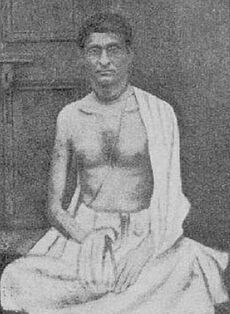
From 1905, Bhaktisiddhanta Saraswati Prabhupāda began giving public talks. He spoke about the philosophy of Chaitanya Vaishnavism. Many educated young Bengalis became his students. He made a vow to recite one billion names of Radha and Krishna, which took him almost ten years. This practice of meditating on the Hare Krishna mantra became very important in his teachings.
Challenging Old Ideas
Bhaktisiddhanta Prabhupāda faced challenges from traditional brahmanas (priests). They believed that only those born into brahmin families could worship certain deities or give spiritual initiations. Bhaktisiddhanta disagreed. He believed that a person's character and spiritual dedication were more important than their birth family.
In 1911, he spoke at a conference in Balighai. He presented a paper called Brāhmaṇa o Vaiṣṇava (Brahmana and Vaishnava). He explained that while brahmanas are important, Vaishnavas (devotees) should be respected even more for their devotion. This event created a rivalry between his followers and the traditional brahmana community.
Spreading Knowledge Through Books
In 1913, Bhaktisiddhanta started a printing press in Calcutta. He called it bhagavat-yantra ("God's machine"). He began publishing old Vaishnava texts, like the Chaitanya Charitamrita, with his own explanations. This showed his commitment to using modern tools to spread Gaudiya Vaishnavism. He was inspired by a letter from his father, Bhaktivinoda, who told him to use printing presses and distribute books to spread pure devotional teachings.
After his father passed away in 1914, and his guru Gaurakishora Dasa Babaji passed away in 1915, Bhaktisiddhanta felt a great responsibility. He decided to move his printing press and focus on establishing a strong center in Calcutta.
Later Period: A Global Mission (1918–1937)
After the passing of his father and guru, Bhaktisiddhanta Sarasvati took on the huge task of continuing their mission. He wanted to revive and protect the Chaitanya tradition. He spoke out strongly against what he saw as wrong practices or misunderstandings of the teachings. His powerful speeches and writings earned him the title "acharya-keshari" ("lion guru").
Becoming a Monk and Founding Gaudiya Math
On 27 March 1918, Bhaktisiddhanta Sarasvati made a big decision. He became the first sannyasi (monk) in the Gaudiya Vaishnava tradition since Chaitanya Mahaprabhu's time. Since there was no other Gaudiya Vaishnava monk to initiate him, he performed the ceremony himself in front of a picture of his guru. He then adopted the life and dress of a renunciant, taking the name Bhaktisiddhanta Sarasvati Goswami.
In December 1918, he opened his first center in Calcutta, called "Calcutta Bhaktivinoda Asana." In 1920, it was renamed "Shri Gaudiya Math." This center offered a place for people to learn about spiritual life, practice devotion, and study Vaishnava texts. It became a model for 64 other Gaudiya Math centers across India and three abroad (in London, Berlin, and Rangoon).
The Gaudiya Math quickly became known for its strong voice on religious and social issues. It published many magazines and newspapers in different languages. These publications, like Nadiya Prakash and The Harmonist, reached many educated people. The Gaudiya Math also held large "theistic exhibitions" with displays and dioramas to explain their philosophy.
Breaking Down Caste Barriers
The Gaudiya Math welcomed people from all backgrounds. Its leaders were educated Bengalis, and it had many monks who traveled to new places. The centers focused on personal discipline, including daily meditation, public singing of Krishna's names (kirtan), studying texts, and worshiping temple images.
Bhaktisiddhanta Sarasvati strongly believed that a person's social background should not stop them from practicing religion. He explained his views in an essay called "Gandhiji's Ten Questions" in 1933. He replied to Mahatma Gandhi's questions about untouchability. Bhaktisiddhanta said that temples should be open to everyone, especially those who wanted to serve God and learn spiritual practices. He believed that true "untouchables" were those who were against serving God, not those from lower social groups. He stressed that all beings are spiritual and equal in relation to God.
True Devotion and Renunciation
Bhaktisiddhanta Sarasvati taught that spiritual growth comes through purity, humility, and service. He also taught a principle called yukta-vairagya, which means "renunciation by engagement." This means using anything in the world to serve God, instead of trying to enjoy it for oneself. Based on this, Bhaktisiddhanta used modern technology like printing presses and transportation to spread his message. He carefully kept the core spiritual teachings while adapting to modern ways. This helped the Gaudiya Math grow and expand globally.
Spreading the Message to Europe
Back in 1882, Bhaktivinoda, Bhaktisiddhanta's father, had a dream. He imagined a day when people in England, France, and America would sing the names of Chaitanya Mahaprabhu. He wanted to see people of all races embrace each other in spiritual brotherhood.
Bhaktivinoda worked to make this vision real. In 1896, he published a book called Srimad-Gaurangalila- Smaranamangala, or Chaitanya Mahaprabhu, His life and Precepts. He sent copies to scholars in the West. The book described Chaitanya Mahaprabhu as a leader of "universal brotherhood and intellectual freedom."
Bhaktisiddhanta inherited this vision from his father. He also received the same inspiration from his mother before she passed away in 1920. So, from the early 1920s, Bhaktisiddhanta began planning his mission to Europe.
In 1927, he started an English magazine. He encouraged British officers to support his movement. In 1935, the Governor of Bengal, John Anderson, even visited Bhaktisiddhanta's headquarters in Mayapur. Bhaktisiddhanta had a map of London and thought about how to expand his mission to the West.
After careful planning, three of his senior disciples arrived in London on 20 July 1933. As a result, the Gaudiya Mission Society was opened in London in 1934. Later, a center was also set up in Berlin, Germany. In 1935, two German converts, Ernst Georg Schulze and Baron H.E. von Queth, visited Calcutta and were welcomed by the Gaudiya Math.
Bhaktisiddhanta believed that if Vaishnavism was explained correctly, intelligent people would be attracted to it. Despite much effort and money, the mission in the West only attracted a few people at first. In 1936, in his final speech to thousands of his followers, Bhaktisiddhanta stressed the importance of spreading Chaitanya's teachings in Western countries. He said, "I have a prediction. However long in the future it may be, one of my disciples will cross the ocean and bring back the entire world."
On 3 December 1936, Bhaktisiddhanta wrote to his disciple Bhaktivedanta. He told him that he was confident Bhaktivedanta could explain their ideas in English to people who didn't know other languages. He said this would be very good for both Bhaktivedanta and his audience.
Shortly after, on 1 January 1937, Bhaktisiddhanta Sarasvati passed away at the age of 63.
Literary Works
Legacy and Impact
The Gaudiya Math movement, started by Bhaktivinoda and developed by Bhaktisiddhanta, became a very strong reform movement in Bengal. It challenged other modern spiritual ideas in India. Bhaktisiddhanta did not name one successor. Instead, he asked his main disciples to work together to lead the mission. However, after he passed away, there were disagreements, and the mission split into several smaller groups.
Despite these challenges, the Gaudiya Math movement slowly grew strong again. In 1966, one of Bhaktisiddhanta's disciples, A.C. Bhaktivedanta Swami, founded the International Society for Krishna Consciousness (ISKCON) in New York City. ISKCON helped spread Chaitanya Vaishnavism around the world.
Today, the movement started by Bhaktisiddhanta Sarasvati includes over forty independent organizations. It has hundreds of centers and more than 500,000 followers worldwide.
Recognition
In November 2023, UNESCO decided to celebrate the 150th birth anniversary of "Srimad Bhakti Siddhanta Saraswati Goswami Prabhupada." They recognized him as a "philosopher, social reformer and eminent spiritual leader." India proposed this, with support from countries like Cuba, Kazakhstan, Russia, Thailand, and Vietnam.
On February 8, 2024, the Prime Minister Narendra Modi released a special stamp and coin in his honor. This was part of a celebration for Bhaktisiddhanta Sarasvati's 150th birth anniversary.
On March 29, 2024, an exhibition was held at the ISKCON TOVP Temple in Mayapur. This exhibition celebrated Srila Bhaktisiddhanta Saraswati Thakur Prabhupada's life and his important contributions to modern Gaudiya Vaishnavism. It showed his travels, spiritual exhibitions, and his many writings and publications. The exhibition included original books, rare photos, and historical documents.
See also
 In Spanish: Bhaktisiddhanta Saraswati para niños
In Spanish: Bhaktisiddhanta Saraswati para niños


